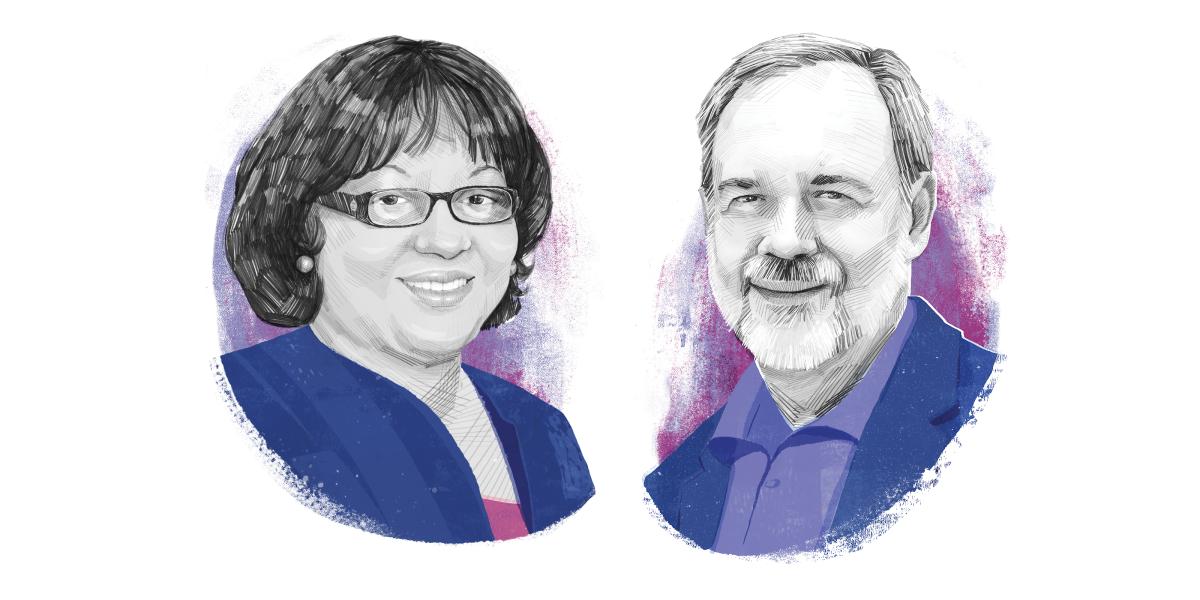Americas’ Health
PAHO director Carissa Etienne and epidemiologist Carlos Castillo-Salgado compare notes on Zika and the future of health in the Americas.
Pan American Health Organization (PAHO) director Carissa Etienne, MBBS, MSc, has a vast responsibility. PAHO, the world’s oldest international public health agency, spans 52 member countries and territories and 1 billion people. Carlos Castillo-Salgado, MD, DrPH ’87, MPH ’81, JD, a PAHO veteran of 22 years and current Epidemiology professor, leads a professional epidemiology certificate program that has trained more than 350 public health managers across Latin America and Spain. In late March, Castillo-Salgado spoke with Etienne about lessons from the Zika outbreak, bright spots in the fight against noncommunicable diseases, and her thoughts on the future of public health and other key topics.
CCS: What are the most important lessons from the Zika outbreak?
CE: One of the first is, do not underestimate your enemy. We had what looked like an innocuous pathogen, [and] we saw more than 700,000 Zika cases and 2,800 cases of congenital Zika syndrome reported to PAHO. We know those numbers represent the tip of the iceberg. Another lesson is the urgent need to invest in new diagnostics, medicines and vaccines for neglected health problems like Ebola and Zika. The world cannot continue neglecting such problems, because of the weak premise that they are limited in scope, or they do not affect major population groups in countries of the North. I think it is totally unacceptable that there was not a vaccine for Ebola. We have had more than 20 previous outbreaks of Ebola documented in Africa. Zika was discovered in 1947, and there was much that was not known. And so we are paying the price for that neglect and inattention. I think also we learned a lesson in terms of vector control [and] the lack of simple, effective, affordable vector control tools.
CCS: I think what you are addressing is very important, particularly with the innovative tools. We would be happy to send you some information that we are working on with different countries on the new concept of citizens’ surveillance. We have been developing tools for recognizing the type of mosquitoes, and using the community as main drivers for the surveillance systems and control efforts.
CE: Thank you.
CCS: Many developed countries are very concerned about problems with vaccination coverage. And in the Americas, it is recorded that almost a million children have not completed the vaccination schedule.
CE: Well, as you know, the vaccination coverage in the region of the Americas, is among the highest in the world. The Revolving Fund for Vaccines, for more than 37 years, has supported the access to vaccines at very affordable prices. As a result, we have eliminated the transmission of many diseases from the Americas: smallpox, polio, rubella, and congenital rubella syndrome. One of the issues that we face is the growing vaccine hesitancy, particularly in North America, leading to the nonvaccination of an important number of children—enough to sustain the transmission of measles. And we know that outbreaks have occurred in the U.S., in recent years.
CCS: What countries do you think have had model programs against noncommunicable diseases?
CE: Certainly, we’ve seen that countries in the Americas have enacted tobacco control legislation and regulations, including front of package labeling, the prohibition of smoking in public places and restrictions on advertising. Leading in that, of course, is Uruguay. Ecuador has an innovative food labeling program. Chile is also introducing food labeling legislation. Several countries, including Mexico, Barbados and Dominica, are increasing taxation on sugar beverages and others are reducing access to them in schools.
It is important to note the pushback from the tobacco, alcohol, food and beverage industries. Some of these are utilizing tactics used previously by the tobacco industry. PAHO member states should act in solidarity to maintain our push for regulations, policies, and interventions that protect health.
CCS: How do you see the development of “health in all policies” in the Americas?
CE: We are the first region in WHO to have a strategy and plan of action on health in all policies. The important question is how to get all sectors engaged in pushing for the legislation and policies that will benefit the health of their population. Certainly the ministries of health have an important role to play, but really, national leadership must take an active role.
CCS: That’s great. How do you see the future of public health? Are you optimistic?
CE: I’m by nature an optimistic person. I see the firm commitment of our member states to move towards universal health coverage. I believe also in the commitment of countries globally to implement the sustainable development agenda, to eradicate poverty, to achieve equity, and importantly, to focus on people who live in conditions of vulnerability. It augurs well for the future of health in the region. The root causes of the health issues that we must respond to are the poverty, inequity, social exclusion and the lack of access to the social determinants of health.
However, I have concerns that with this uncertain financial situation, all countries need to commit to increasing the domestic investments for health. We advocate for 6 percent of GDP to be primarily domestic investments for health, and many countries have not attained this target. I also see the high level NCDs as being significant—contributing not just to mortality, but to disabilities and absenteeism from work. Finally, we must address the persistent inequity. I know that our region has been named the most inequitable region. Even as I see countries moving, and working to address inequity, it will require some radical changes, and some radical reorientation of many of the programs.
